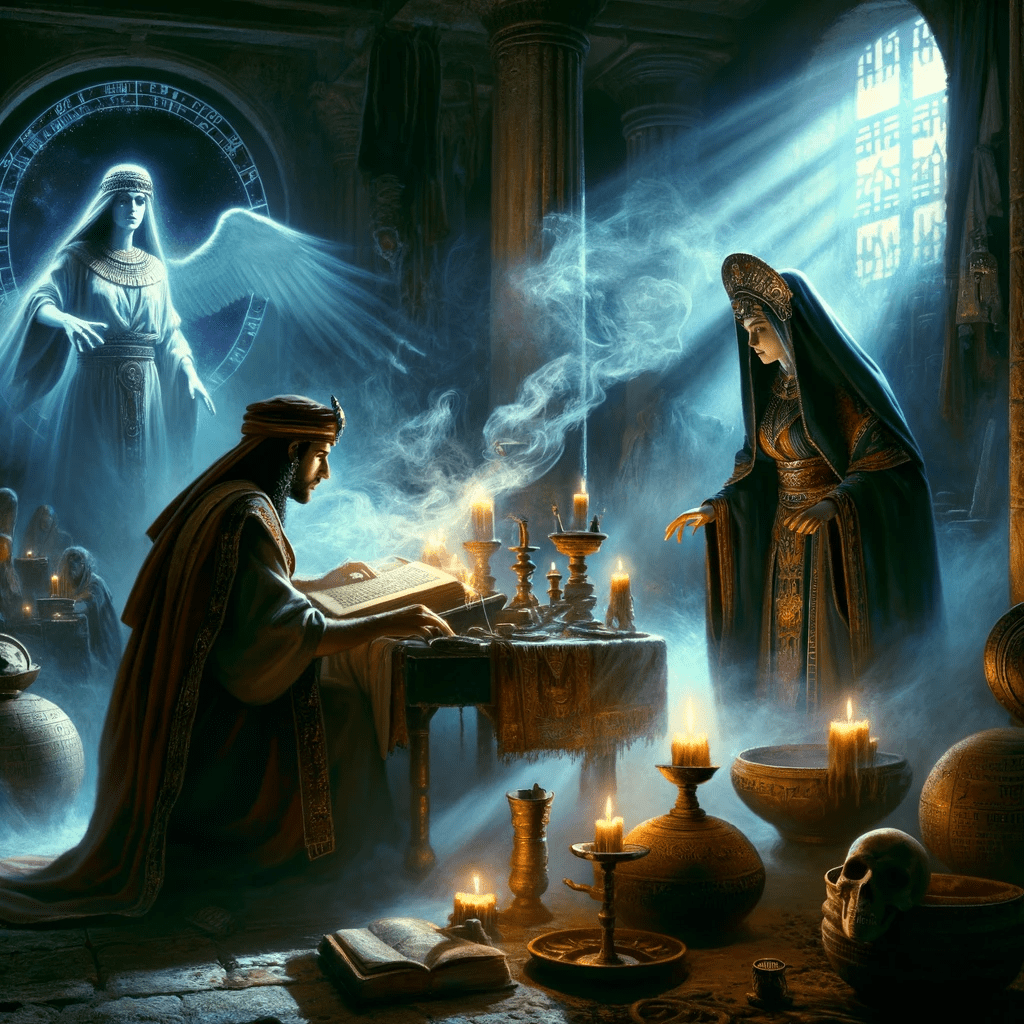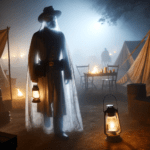Necromancy is the practice of communicating with the dead, often for the purpose of divination or summoning spirits. This practice has been a part of human history for centuries and is mentioned in many ancient texts. These texts describe various rituals and practices associated with necromancy, which have influenced modern practices.
One of the earliest mentions of necromancy comes from the Odyssey, where Odysseus consults with the dead in order to gain knowledge of his future. In ancient Egypt, the Book of the Dead contained spells and incantations that were believed to help the deceased navigate the afterlife. The ancient Greeks and Romans also practiced necromancy, often using it for divination or to communicate with the dead.

Today, modern practices of necromancy are derived from these ancient rituals, but with some variations. While some people still use traditional methods such as ouija boards and seances to communicate with the dead, others use electronic voice phenomena (EVP) or other technological means. Some practitioners of modern necromancy also incorporate elements of other spiritual practices, such as Wicca or shamanism.
Historical Context of Necromancy
Origins and Definitions
Necromancy is a form of divination that involves communicating with the dead. The word “necromancy” comes from the Greek words “nekros” (meaning “dead”) and “manteia” (meaning “divination”). The practice has been around for thousands of years and can be traced back to ancient civilizations such as Egypt, Greece, and Rome.
In ancient times, necromancy was often associated with black magic and was considered taboo. It was typically practiced by priests, priestesses, or other individuals who had special knowledge or abilities. The practice involved various rituals and spells that were used to summon the spirits of the dead and gain insight into the future.
Cultural Perspectives
Necromancy was viewed differently in different cultures. In ancient Egypt, for example, it was believed that the deceased could provide guidance and protection to the living. Necromancy was therefore an important part of Egyptian religion and was often practiced by priests and priestesses.
In ancient Greece, necromancy was associated with the underworld and was often used to gain knowledge or insight from the dead. The most famous example of necromancy in Greek mythology is the story of Odysseus, who consulted the seer Tiresias in the underworld.

In medieval Europe, necromancy was viewed as a form of witchcraft and was often associated with Satanism. It was considered a serious crime and was punishable by death.
Today, necromancy is still practiced in some cultures and is often associated with spiritualism or mediumship. While the practice is still considered taboo by many, it has gained a certain level of acceptance in some circles.
Ancient Descriptions of Necromancy
Egyptian Texts
In ancient Egypt, necromancy was often associated with the god Osiris and the afterlife. The Book of the Dead, a collection of spells and prayers intended to guide the deceased through the afterlife, contains references to necromancy. One spell, known as Spell 154, describes a ritual in which the deceased summons the spirit of a dead person to answer questions about the afterlife. The spell involves burning incense and reciting specific words and phrases to summon the spirit.
Greek and Roman Accounts
In ancient Greece and Rome, necromancy was often associated with the underworld and the god Hades/Pluto. The Greek historian Herodotus wrote about a group of people known as the Magi who were said to practice necromancy. He described how they would dig a pit and pour libations of milk, honey, and wine into it, then wait for the spirits to appear. The Roman poet Virgil also wrote about necromancy in his epic poem, the Aeneid. In Book VI, the hero Aeneas visits the underworld and consults with the spirit of his father.
Biblical References
The Bible contains several references to necromancy, which is generally portrayed in a negative light. In Deuteronomy 18:10-12, for example, necromancy is listed as one of the practices that are forbidden by God. In the New Testament, the story of the Witch of Endor (1 Samuel 28) describes how King Saul consulted with a medium to summon the spirit of the prophet Samuel. The story is often cited as an example of the dangers of necromancy and the importance of obeying God’s laws.

Rituals and Practices
Summoning the Dead
Ancient texts describe necromancy as a practice of summoning the dead to communicate with them. This was done through various rituals and incantations, which were believed to have the power to bring the dead back to the realm of the living. The rituals were often performed in graveyards or other places associated with death.
One common method of summoning the dead was to create a circle of salt around the practitioner, which was believed to create a barrier between the living and the dead. The practitioner would then call upon the spirit of the deceased, using a specific incantation or prayer. Some texts describe the use of candles and other items to aid in the summoning process.
Divination Methods
In addition to summoning the dead, necromancy was also used as a means of divination. This involved using the spirits of the dead to gain insight into the future or to answer specific questions. The practitioner would often use a variety of tools, such as tarot cards or a crystal ball, to aid in the divination process.
One common method of divination was to use the bones of the deceased. The practitioner would cast the bones and interpret their positions and patterns to gain insight into the future. Another method involved using the entrails of animals, which were believed to have prophetic properties.
Modern practices derived from these rituals include various forms of divination, such as tarot reading and crystal ball gazing. However, it is important to note that necromancy is generally considered to be a taboo practice in modern society, and is often associated with dark magic and the occult.
Modern Interpretations
Literary Influence
Modern literature has been heavily influenced by ancient texts describing necromancy. Many popular fantasy and horror novels have incorporated elements of necromancy into their stories, often portraying it as a dark and dangerous practice. For example, the Harry Potter series by J.K. Rowling features the character of Lord Voldemort, who uses necromancy to create an army of undead creatures to do his bidding.
Similarly, George R.R. Martin’s A Song of Ice and Fire series includes characters who practice necromancy, such as the Red Priestess Melisandre, who uses her powers to bring people back from the dead. These literary depictions of necromancy have helped to shape modern perceptions of the practice, associating it with evil and dark magic.
Cinematic Portrayals
Necromancy has also been a popular theme in movies and television shows. One of the most well-known examples is the Evil Dead franchise, which features a group of friends who accidentally unleash evil spirits through the use of a necronomicon, an ancient book of the dead. The franchise has spawned numerous sequels and spin-offs, cementing its place in popular culture.
Other popular movies and shows that feature necromancy include The Walking Dead, which portrays a post-apocalyptic world overrun by zombies, and The Conjuring, which tells the story of a family haunted by a malevolent spirit. These cinematic portrayals often depict necromancy as a dangerous and forbidden practice, with dire consequences for those who dabble in it.
Overall, modern interpretations of necromancy have been heavily influenced by ancient texts, portraying it as a dark and dangerous practice associated with evil and death. These depictions have helped to shape popular perceptions of the practice, influencing everything from literature to film and television.
Contemporary Occult Practices
Ritualistic Elements
Modern practitioners of necromancy often incorporate various ritualistic elements into their practices. These may include the use of candles, incense, and other tools to create a specific atmosphere or to evoke certain energies. Some practitioners also use sigils or symbols to represent specific entities or energies they wish to invoke.
In addition to these physical elements, many practitioners also incorporate specific words or chants into their rituals. These may be derived from ancient texts or may be created by the practitioner themselves. The purpose of these words and chants is to focus the practitioner’s intention and to create a connection with the energies they wish to work with.
Psychological Viewpoints
While some practitioners of necromancy believe in the literal existence of spirits and entities, others view their practices from a psychological perspective. These practitioners see the spirits and entities they work with as representations of different aspects of the human psyche.
From this perspective, the practice of necromancy can be seen as a form of self-exploration and personal growth. By working with these representations of different aspects of themselves, practitioners can gain insight into their own thoughts, emotions, and behaviors.
Overall, contemporary occult practices related to necromancy are diverse and varied. While some practitioners focus on the literal summoning of spirits and entities, others view their practices from a psychological perspective. Regardless of the approach taken, the use of ritualistic elements and the focus on intention and connection remain central to these practices.
Frequently Asked Questions
What are the historical methods used to perform necromancy?
The methods used to perform necromancy varied across different cultures and time periods. However, common practices included the use of divination tools such as mirrors, crystals, and pendulums. Some necromancers also used herbs and potions to create a trance-like state in which they could communicate with the dead. In some cases, blood sacrifice was used to appease the spirits and gain their favor.
Can you describe the necromancy rituals of ancient Greece?
In ancient Greece, necromancy was often performed in underground caves or tombs. The necromancer would make offerings to the gods and then invoke the spirit of the deceased using incantations and spells. The spirit was believed to appear in the form of a shadowy figure or a mist. The necromancer would then ask the spirit for guidance or information.
What role did necromancy play in ancient Roman culture?
Necromancy was a common practice in ancient Rome, especially among the upper classes. The Romans believed that the dead had the power to influence the living and could provide guidance and protection. Necromancy was often used to communicate with ancestors or to gain insight into the future. However, the practice was also associated with witchcraft and was sometimes condemned by religious authorities.
How have modern practices of necromancy been influenced by ancient texts?
Modern practices of necromancy have been influenced by a variety of ancient texts, including the Bible, the works of Plato and Aristotle, and medieval grimoires. Many modern necromancers draw on these sources for inspiration and guidance. However, modern practices also incorporate elements of psychology, spirituality, and other esoteric traditions.
What are the characteristics of a necromancer as depicted in historical literature?
Necromancers were often depicted as mysterious and powerful figures who possessed secret knowledge and the ability to communicate with the dead. They were sometimes feared and ostracized by society, but were also sought after for their abilities. In some cases, necromancers were associated with witchcraft and were persecuted by religious authorities.
In what ways have contemporary necromancy practices diverged from classical descriptions?
Contemporary necromancy practices have diverged from classical descriptions in a number of ways. Many modern necromancers focus on spiritual growth and self-improvement, rather than simply seeking guidance or information from the dead. Some modern practices also incorporate elements of technology, such as using EVP (Electronic Voice Phenomenon) to communicate with spirits. Additionally, modern necromancers often draw on a variety of cultural and spiritual traditions, rather than adhering to a single tradition or set of practices.




